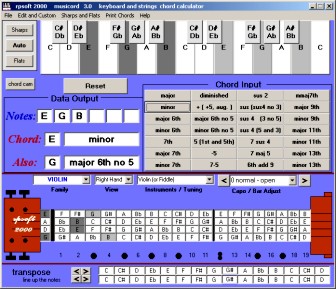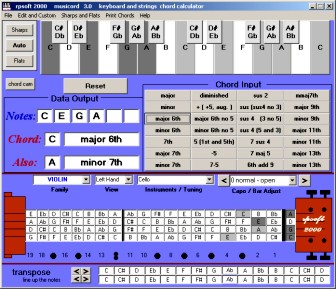| |
Forward
This page shows example usage of
rpsoft 2000 software "musicord" for violin family chord applications. To
view the main page of this software and view its main characteristics,
view it here at: musicord.
Violin (Family)
Chords
in the new Musicord 3.0
With
difficulties of handling more than two strings at once with a bow,
playing chords on a violin, fiddle, viola or cello takes some
creativity. Whichever method you might wish to use to play
chords with a member of the violin family, one of the first difficulties
lies in understanding the fingering for the chords. For that part,
Musicord vs. 3.0 can be a big help.
Violins of course do not have "frets" but
instead have fingering positions. Consider the fret images below
as being fingering positions. Musicord 3.0 will handle 4 string, 5
string or 6 string instruments (and even more for instruments such as
the mandolin with string pairs). For the violin family, a number
of instruments and tunings are provided. If you decide that you
wish a different tuning, custom tunings and even the storage of them is
provided for in Musicord 3.0. Both right hand and left hand
viewing is available.
| |
 |
|
 |
|
| |
|
|
|
|
| |
The above shows the musicord screen for
an E minor chord for a standard violin tuning |
|
The above shows the musicord screen
for a C major 6th chord for a cello showing a left view. |
|
Basic Applications:
Not only will this software recognize notes to chords
or chords to note -
for 28 chord types - and also show the notes inside those chords if
wished - it also shows stringed instrument guitar fingering down the neck of the guitar.
Chords Recognized / Created
28 chords in all,
including: major, minor, major 6th, minor 6th, 7th, major 7th,
minor 7th, mmaj7th, major 9th, minor 9th, major 11th, minor 11th, major
13th, minor 13th,diminished, augmented (also called + or +5), major 6
with no 5, minor 6th with no 5, 5, -5, 7-5, sus 2, sus (sus 4 no 3),
sus4 (3 no 5), sus 4 (5 and 3), 7 sus 4, 7 maj 5, 6th add 9.
Violin "Family" Presets and Tuning
(available for right or left hand viewing)
Violin (or Fiddle), Viola, Cello, Soprano
Violin, Treble Violin, Tenor Violin, Baritone Violin, Bass Violin,
Double Bass, Contrabass, Bass (Bull) Fiddle, Viol Treble, Viol Tenor,
Viol Bass
Unique Tunings and
Storage of Favorite Tunings
If none of the above preset tunings will
work for you, Musicord also allows you to adjust each string to any
chromatic note you wish. And you can use this feature with 4
string, 5 string and 6 string stringed instruments. If you are an artist who
often uses several different tunings, you can store your custom tunings
and they will be available to you as options under the Musical Family
"Custom".
Chords to Notes
To determine the
notes in a chord such as C major, one begins by entering the C by either
pressing a C on the piano keyboard or a C on the stringed instrument
fingering area.
Then use the mouse pointer to select the “major” button on the chords at
the right middle of the program. The notes are then shown in the
data output. The fingering is also show on the piano and on the
string positions.
Fingering Options
Dark gray areas show
the primary (lowest possible) fingering. Light gray areas show
duplicate fingering that could be substituted if the person wishes. For
example, one could substitute a light gray C note fingering for a dark
gray C note fingering. Substitutes may make the fingering easier,
or make for a better sound in the particular circumstance. On the
piano, allowing different notes at the top of the chord lead to
different “inversions” of the same chord.
Options allow one to
see fingerings down the stringed instrument neck by using a “capo” option.
This option shows fingerings, four frets at a time, moving down the
neck. In this way one might find an easier, faster, or better
sounding chord fingering.
Notes to Chords
One can also enter
notes on the piano keyboard or the stringed instrument fret board, and then see if
the software program recognizes the chord. If it does, the program
will show the chord name, (piano chord or stringed instrument chord) and any
alternates, in the data area.
What if one wants to
see stringed instrument fingering for a combination of notes that are
not one of the 28 listed chords? Entering the notes on the piano
keyboard or stringed instrument will
show the note fingering on the stringed instrument fret board even if it is not one
of the 28 chords.
More Options
Even more options,
including printing, making custom tunings or instruments shown on the
main musicord page. To see these,
click here.
Relevant Links
(includes this page)
General:
Musicord Software- main page,
Left Hand Chord Example,
Retuned Strings Example
Musical Instrument
Families
Keyboard / Piano,
Guitar / Tiple,
Bass Guitar,
Ukulele,
Banjo, Mandolin / Bouzouki /
Cittern,
Violin / Fiddle / Viola / Cello,
Steel Guitar / Dobro,
Lute / Oud / Cumbus
Click Here for
eBook Info on One Person Band Recording
If you wish to Download and Try,
Click
here for the Download page. Note that you must also agree with our
rules and liability exclusion.
return
To rpsoft 2000 software
|
|